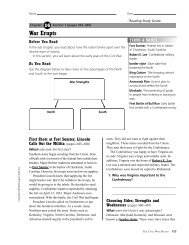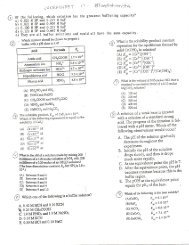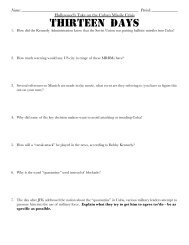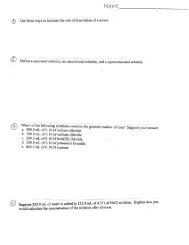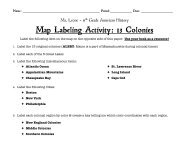Chapter 16 Text
Chapter 16 Text
Chapter 16 Text
Create successful ePaper yourself
Turn your PDF publications into a flip-book with our unique Google optimized e-Paper software.
<strong>16</strong>.6 Weak Acids 629<br />
Calculating Ka from pH<br />
In order to calculate either the Ka value for a weak acid or the pH of its solutions,<br />
We will use many of the skills for solving equilibrium problems that we developed<br />
in Section 15.5. In many cases the small magnitude of Ka allows us to use approximations<br />
to simplify the problem. In doing these calculations, it is important to realize<br />
that proton-transfer reactions are generally very rapid. As a result, the measured<br />
Or calculated pH of a solution always represents an equilibrium condition.<br />
SAMPLE EXERCISE <strong>16</strong>.10<br />
A student prepared a 0.10 M solution of formic acid (HCHO2) and measured its pH using a pH meter of the type illustrated in Figure<br />
<strong>16</strong>.6- The pH at 25°C was found to be 2.38. (a) Calculate Ka for formic acid at this temperature, (b) What percentage of the acid is<br />
ionized in this 0.10 M solution?<br />
Solution<br />
Analyze: We are given the molar concentration of an aqueous solution of weak acid and the pH of the solution at 25°C, and we<br />
are asked to determine the value of Ka for the acid and the percentage of the acid that is ionized.<br />
Plan: Although we are dealing specifically with the ionization of a weak acid, this problem is very similar to the equilibrium problems<br />
we encountered in <strong>Chapter</strong> 15. We can solve it using the method first outlined in Sample Exercise 15.8, starring with the<br />
chemical reaction and a tabulation of initial and equilibrium concentrations.<br />
Solve: (a) The first step in solving any<br />
equilibrium problem is to write the<br />
equation for the equilibrium reaction.<br />
The ionization equilibrium for formic<br />
acid can be written as follows:<br />
The equilibrium-constant expression is<br />
From the measured pH we can calculate<br />
[H+]:<br />
= [H+][CH02n<br />
[HCH021<br />
pH = -log[H+] = 2.38<br />
log[H+] - -2.38<br />
CHO2~(ac})<br />
[H+l = 10"2-38 = 4.2 x 10"3 M<br />
We can do a little accounting to determine<br />
the concentrations of the species<br />
involved in the equilibrium. We imagine<br />
that the solution is initially 0.10 M in<br />
HCHO2 molecules. We then consider<br />
the ionization of the acid into H+ and<br />
CHO2~. For eachHCHO2 molecule that<br />
ionizes, one H+ ion and one CHO2~ ion<br />
are produced in solution. Because the pH<br />
measurement indicates that [H+] =<br />
4.2 X 1(T3 M at equilibrium, we can<br />
construct the following table:<br />
Initial<br />
Change<br />
Equilibrium<br />
; 0.10 M<br />
-4.2 X 10~3 M<br />
(0.10 ~ 4.2 x 10"3) M<br />
0<br />
+4.2 X 10~3 M<br />
4.2 X 10~3 M<br />
0<br />
+4.2 X 10~3 M<br />
4.2 X 10~3M<br />
Notice that we have neglected the very<br />
small concentration of H+(flq) due to<br />
the autoionization of H2O. Notice also<br />
that the amount of HCHO2 that ionizes<br />
is very small compared with the<br />
initial concentration of the acid. To the<br />
number of significant figures we are<br />
using, the subtraction yields 0.10 M:<br />
We can now insert the equilibrium<br />
concentrations into the expression for<br />
Kn:<br />
(0.10 - 4.2 X 10~3)M * 0.10 M<br />
(4.2 x 10~3)(4.2 x 10~3)<br />
0.10<br />
= 1.8 x 10"4<br />
Check: The magnitude of our answer is reasonable because Ka for a weak acid is usually between 10 3 and 10 10.<br />
(b) The percentage of acid that ionizes<br />
is given by the concentration of H+ or<br />
CHO2~ at equilibrium, divided by the ,-11<br />
' multiPlied = X 10°% * ~ X 10°% =



